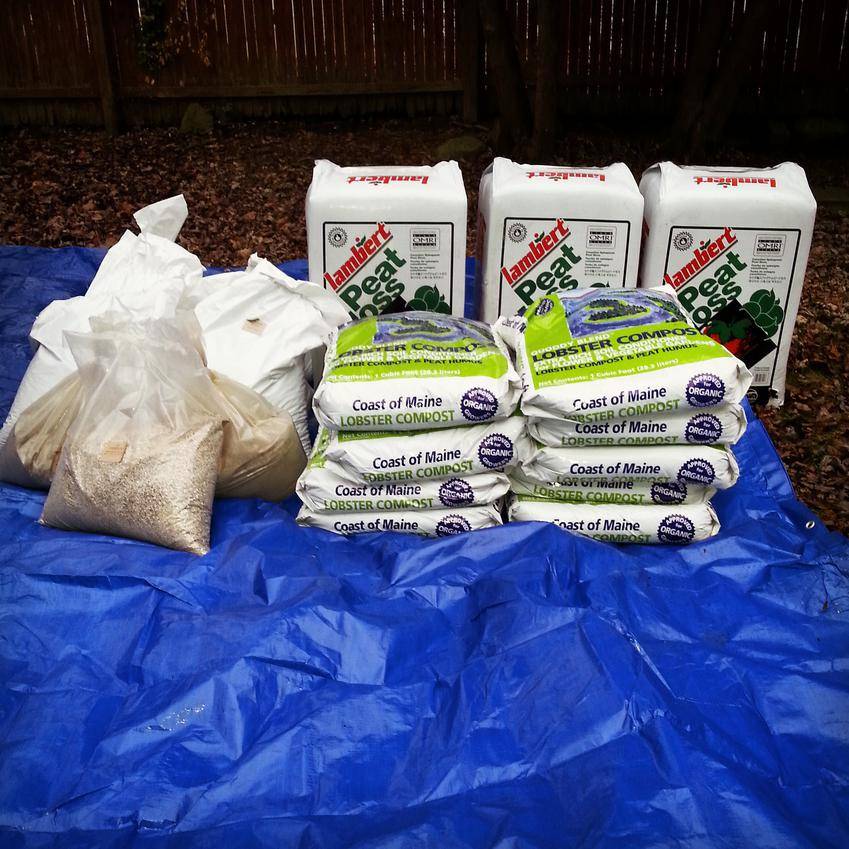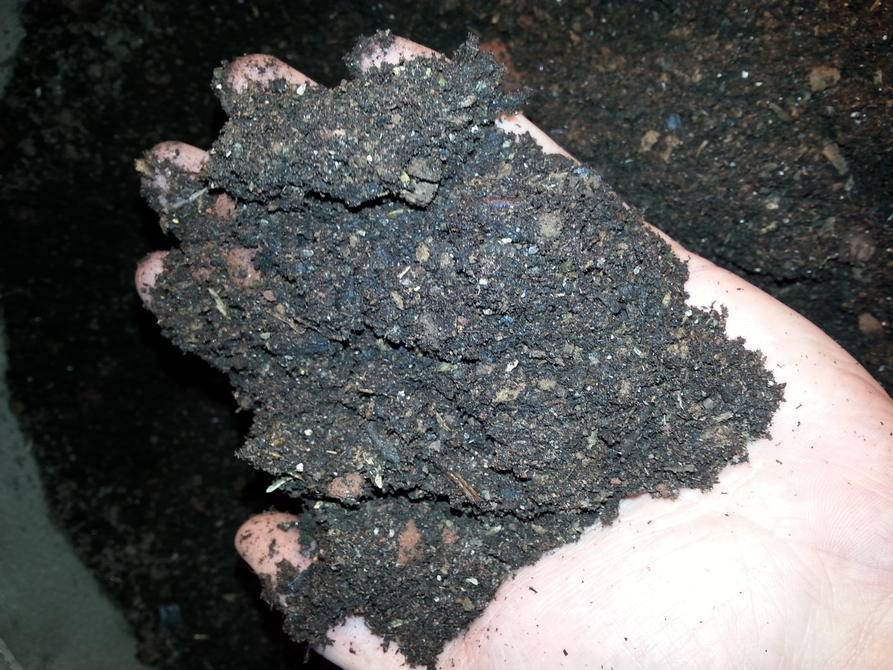IT'S GAME TIME!
IT'S GAME TIME!
So the lava rock that was back ordered came in a few days ago (not pictured below), so I was able to get this yard of soil mixed up finally. I'm such an anxious person too... these last few weeks have been torture!!!

This mix includes:
1 part Peat Moss
1 part Aeration (75% lava rock, 20% bio char, 5% rice hulls)
1 part Compost
Mixed with:
Acadian Kelp Meal @ 1/2 Cup per cubic foot
Neem Cake and Karanja Cake 50/50 Mix @ 1/2 cup per cubic foot
Crustacean Meal @ 1/2 Cup per cubic foot
Gypsum Dust @ 1 Cup Per Cubic Foot
Brix Blend Basalt @ 1 Cup Per Cubic Foot
Glacial Rock Dust @ 1 Cup Per Cubic Foot
Oyster Flour @ 1 Cup Per Cubic Foot

I took these shots through the scope to show the differences between Red Lava Rock and Perlite. If you were a microorganism, would you rather live on the bare surface of the perlite? Or deep in the caves of the lava rock, where thousands of mini "micro climates" are found that contain moisture? This is why I chose Lava Rock over Perlite. The only down side is the added weight to the containers, I can no longer pick them up and carry them so now I just slide them around... no biggie though! Soil life > my life.

Oh yeah, I've also changed the base of my containers for drainage purposes. I can't believe I waited so long to do this... BlueJay over at GC gave me this tip. Hopefully this helps avoid those soggy container bottoms that I used to have...
Edit: After further discussion, I've come to the conclusion that laying rocks down indeed does not increase drainage efficiency - but can be of benefit if your pots are sitting on the cold floor (especially in winter) to act as a layer of insulation. Oops!

Finished soil, ready for the new containers. God damn I love the feeling of rich soil...

Finally! The new no-tills are ready for action...
I'll brew up an inoculation tea with every type of humus I own (diversity) and drench before waiting a week or two for the amendments to break down before planting cover crops and clones. There isn't anything "hot" in this mix, so it doesn't require the typical 4 week "cook" like most super soil mixes do with harsher (and unnecessary) additives. As for cover crops, I'll be using Fenugreek and Crimson Clover to fix nitrogen and provide additional nutrients to the soil. After the canopy fills in in late veg, a natural "chop & drop" will be performed by nature and most of the N will be used up during the last weeks of veg and the first week(s) of flowering.
As stated before, I've altered this mix a little bit compared to the original mix I ran in the beginning of this thread. I've taken out the fish bone meal due to it's high P properties and it's affect on mycorrhizae, incorporated amendments that don't break down over time (like the rice hulls I originally used), added Bio Char (pre-charged) in my aeration for long term nutrient retention/soil fertility, and will be adding worms to my pots for the first time to provide fresh castings and additional aeration from their "tilling" affect. I've also bumped the size of my containers from 10 gallons to 25 gallons for bigger plants/more production. I'll be squeezing (10) 25 gallon no-tills into the 5'x10' tent.
Stay tuned!!
IT'S GAME TIME!
So the lava rock that was back ordered came in a few days ago (not pictured below), so I was able to get this yard of soil mixed up finally. I'm such an anxious person too... these last few weeks have been torture!!!
This mix includes:
1 part Peat Moss
1 part Aeration (75% lava rock, 20% bio char, 5% rice hulls)
1 part Compost
Mixed with:
Acadian Kelp Meal @ 1/2 Cup per cubic foot
Neem Cake and Karanja Cake 50/50 Mix @ 1/2 cup per cubic foot
Crustacean Meal @ 1/2 Cup per cubic foot
Gypsum Dust @ 1 Cup Per Cubic Foot
Brix Blend Basalt @ 1 Cup Per Cubic Foot
Glacial Rock Dust @ 1 Cup Per Cubic Foot
Oyster Flour @ 1 Cup Per Cubic Foot
I took these shots through the scope to show the differences between Red Lava Rock and Perlite. If you were a microorganism, would you rather live on the bare surface of the perlite? Or deep in the caves of the lava rock, where thousands of mini "micro climates" are found that contain moisture? This is why I chose Lava Rock over Perlite. The only down side is the added weight to the containers, I can no longer pick them up and carry them so now I just slide them around... no biggie though! Soil life > my life.
Oh yeah, I've also changed the base of my containers for drainage purposes. I can't believe I waited so long to do this... BlueJay over at GC gave me this tip. Hopefully this helps avoid those soggy container bottoms that I used to have...
Edit: After further discussion, I've come to the conclusion that laying rocks down indeed does not increase drainage efficiency - but can be of benefit if your pots are sitting on the cold floor (especially in winter) to act as a layer of insulation. Oops!
Finished soil, ready for the new containers. God damn I love the feeling of rich soil...
Finally! The new no-tills are ready for action...
I'll brew up an inoculation tea with every type of humus I own (diversity) and drench before waiting a week or two for the amendments to break down before planting cover crops and clones. There isn't anything "hot" in this mix, so it doesn't require the typical 4 week "cook" like most super soil mixes do with harsher (and unnecessary) additives. As for cover crops, I'll be using Fenugreek and Crimson Clover to fix nitrogen and provide additional nutrients to the soil. After the canopy fills in in late veg, a natural "chop & drop" will be performed by nature and most of the N will be used up during the last weeks of veg and the first week(s) of flowering.
As stated before, I've altered this mix a little bit compared to the original mix I ran in the beginning of this thread. I've taken out the fish bone meal due to it's high P properties and it's affect on mycorrhizae, incorporated amendments that don't break down over time (like the rice hulls I originally used), added Bio Char (pre-charged) in my aeration for long term nutrient retention/soil fertility, and will be adding worms to my pots for the first time to provide fresh castings and additional aeration from their "tilling" affect. I've also bumped the size of my containers from 10 gallons to 25 gallons for bigger plants/more production. I'll be squeezing (10) 25 gallon no-tills into the 5'x10' tent.
Stay tuned!!








